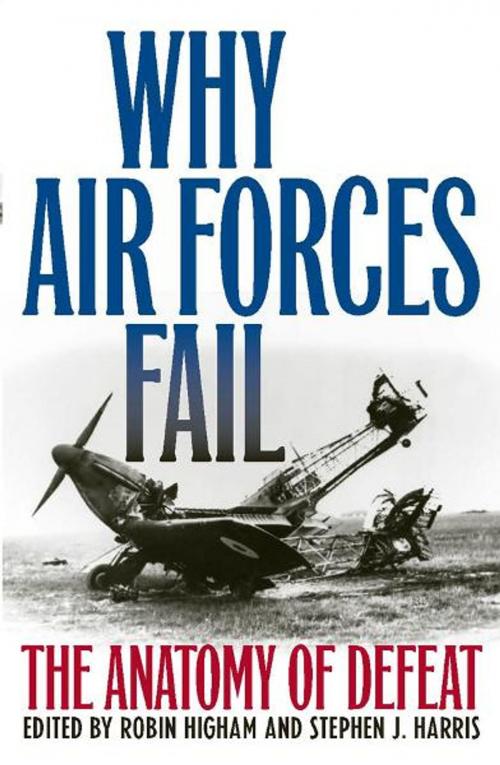Why Air Forces Fail
The Anatomy of Defeat
Nonfiction, Science & Nature, Technology, Military Science, History, Military, Strategy, Aviation| Author: | ISBN: | 9780813137674 | |
| Publisher: | The University Press of Kentucky | Publication: | February 17, 2006 |
| Imprint: | The University Press of Kentucky | Language: | English |
| Author: | |
| ISBN: | 9780813137674 |
| Publisher: | The University Press of Kentucky |
| Publication: | February 17, 2006 |
| Imprint: | The University Press of Kentucky |
| Language: | English |
According to Robin Higham and Stephen J. Harris, "Flight has been part of the human dream for aeons, and its military application has likely been the dark side of that dream for almost as long." In the twentieth century, this dream and its dark side unfolded as the air forces of the world went to war, bringing destruction and reassessment with each failure. Why Air Forces Fail examines the complex, often deep-seated, reasons for the catastrophic failures of the air forces of various nations. Higham and Harris divide the air forces into three categories of defeat: forces that never had a chance to win, such as Poland and France; forces that started out victorious but were ultimately defeated, such as Germany and Japan; and finally, those that were defeated in their early efforts yet rose to victory, such as the air forces of Britain and the United States.
The contributing authors examine the complex causes of defeats of the Russian, Polish, French, British, Italian, German, Argentine, and American air services. In all cases, the failures stemmed from deep, usually prewar factors that were shaped by the political, economic, military, and social circumstances in the countries. Defeat also stemmed from the anticipation of future wars, early wartime actions, and the precarious relationship between the doctrine of the military leadership and its execution in the field.
Anthony Christopher Cain's chapter on France's air force, l'Armée de l'Air, attributes France's loss to Germany in June 1940 to a lack of preparation and investment in the air force. One major problem was the failure to centralize planning or coordinate a strategy between land and air forces, which was compounded by aborted alliances between France and countries in eastern Europe, especially Poland and Czechoslovakia. In addition, the lack of incentives for design innovation in air technologies led to clashes between airplane manufacturers, laborers, and the government, a struggle that resulted in France's airplanes' being outnumbered by Germany's more than three to one by 1940.
Complemented by reading lists and suggestions for further research, Why Air Forces Fail provides groundbreaking studies of the causes of air force defeats.
According to Robin Higham and Stephen J. Harris, "Flight has been part of the human dream for aeons, and its military application has likely been the dark side of that dream for almost as long." In the twentieth century, this dream and its dark side unfolded as the air forces of the world went to war, bringing destruction and reassessment with each failure. Why Air Forces Fail examines the complex, often deep-seated, reasons for the catastrophic failures of the air forces of various nations. Higham and Harris divide the air forces into three categories of defeat: forces that never had a chance to win, such as Poland and France; forces that started out victorious but were ultimately defeated, such as Germany and Japan; and finally, those that were defeated in their early efforts yet rose to victory, such as the air forces of Britain and the United States.
The contributing authors examine the complex causes of defeats of the Russian, Polish, French, British, Italian, German, Argentine, and American air services. In all cases, the failures stemmed from deep, usually prewar factors that were shaped by the political, economic, military, and social circumstances in the countries. Defeat also stemmed from the anticipation of future wars, early wartime actions, and the precarious relationship between the doctrine of the military leadership and its execution in the field.
Anthony Christopher Cain's chapter on France's air force, l'Armée de l'Air, attributes France's loss to Germany in June 1940 to a lack of preparation and investment in the air force. One major problem was the failure to centralize planning or coordinate a strategy between land and air forces, which was compounded by aborted alliances between France and countries in eastern Europe, especially Poland and Czechoslovakia. In addition, the lack of incentives for design innovation in air technologies led to clashes between airplane manufacturers, laborers, and the government, a struggle that resulted in France's airplanes' being outnumbered by Germany's more than three to one by 1940.
Complemented by reading lists and suggestions for further research, Why Air Forces Fail provides groundbreaking studies of the causes of air force defeats.















